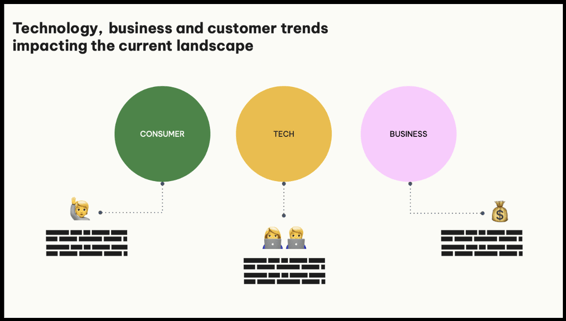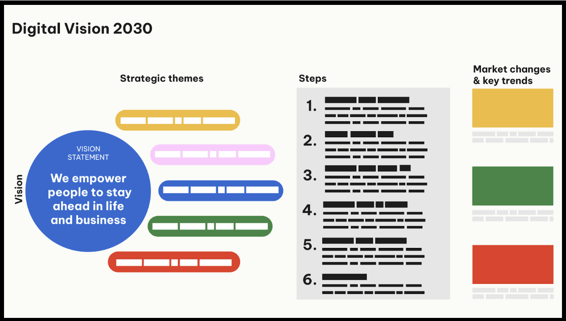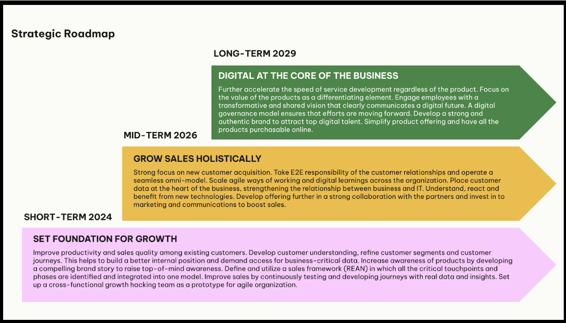Digitalization is not just an option but a must-have, as providing digital services has become mainstream. But as technology progresses and opens up new opportunities, keeping pace with the latest developments is no easy feat. Many organizations are left trailing behind their competitors or fail to realize the potential that digital solutions could offer. Amidst this turbulence, a digital strategy becomes a vital tool.
Digital strategy is an integral part of the overall business strategy. It’s a tool that can help you turn an overwhelming sea of digital opportunities into concrete, actionable steps for your organization. In essence, it outlines how an organization uses digital tools and technologies to achieve its goals and objectives.
Digital strategy is not just a task that should be outsourced to the IT department. Rather, it defines the whole organization’s relationship with digital services, detailing who the organization serves through its digital channels, what those channels are, and what the digital presence is like.
Understanding the digital landscape
Digital strategy work starts by forming a solid overall understanding of the organization, its current practices and capabilities, as well as the environment in which it operates. This includes conducting studies that consider various perspectives, such as studying background materials, conducting interviews, analyzing competitors, and engaging in other types of analysis.
The first step in creating a digital strategy is to understand existing practices and assess what is currently achievable. Essentially, what do the current digital capabilities, IT infrastructure, and organizational structures allow?

Organizations have to meet the needs of clients and stakeholders. Determining who the digital strategy should serve is a crucial step. Before proceeding, it’s essential to identify the key stakeholders and clarify who the target audience is to ensure the effectiveness of the chosen actions. Additionally, it’s necessary to examine the general trends within the industry and investigate what others in the field are doing. What are the best practices, and where might there be room for improvement?
Defining the digital vision and strategy core
The second phase in creating a digital strategy may include developing scenarios for the future that describe how the organization could cater value to its different target groups. Based on these scenarios, you can formulate the digital vision for a specified time in the future.

The digital vision outlines where the organization aims to be at a future date (for example, 5 years from now) regarding its digital presence and capabilities. It serves as a target for guiding actions. From this vision, you can crystalize the core of the digital strategy. A well-defined vision also helps set measurable goals that guide future actions and allow for tracking progress toward achieving those goals. Should there be a deviation from the plan, your organization can quickly adjust and realign its vision and strategy in response to changes in the world.
Planning the digital journey ahead
Now is the time to think about how to make the strategy bear fruit. This requires a careful ideation and prioritization of measures and development projects that need to be undertaken. A strategic roadmap enables you to divide the future timeline, which spans multiple years, into a set of high-level objectives. However, these objectives alone are often too open-ended and broad. This is where a development roadmap comes in. It is a plan of more concrete actions that enable attaining the strategic objectives.

To realize the goals set forth in the digital strategy, an appropriate architecture is essential. Thus, the digital vision should be complemented by a description of the targeted technological state – an architectural vision. Building on this, you can then formulate the desired state of architecture. This specifies the roles of various technologies and solutions and how they interconnect, to create the best possible value and experience. This is further enhanced by recommendations for the development and implementation processes.
Bringing it all together
In summary, creating a digital strategy requires carefully studying your organization’s current state and digital capabilities. Once the current state is understood and the key stakeholders are identified, you can establish a digital vision using scenarios. Finally, you can create a digital roadmap to provide a clear path for the journey ahead.
For a company to thrive in an increasingly digital world, a digital strategy is a must-have. It serves as a powerful tool and a valuable asset that enables organizations to reap the benefits of digital solutions. Vincit is ready to be your partner not only in shaping the digital strategy but also in realizing it by supporting you throughout your digital journey.
Take the first step in your digital transformation journey. Contact us and let's craft a digital strategy that positions your organization for the future.

Jani Tikka,
Designer


